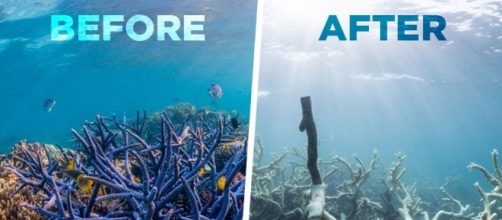The Great Barrier Reef has for years lured tourists to its 3,000 individual reef systems but is under constant threat from warmer water temperatures, cyclones, and even pesky starfish.
Coral Bleaching in 2016 wiped out nearly 600 kilometers of coral, affecting a vast aquatic array of fish, anemones, and starfish. But bleaching from globally warming seas is a small part of the loss of the overall reefs. Just 10 percent of the 50 percent reduction in coral (from 1985 to 2012) was due to coral bleaching. The other 90 percent is attributable to cyclone effects and the insidious Crown of Thorns Starfish.
Bleaching occurs when the ocean's temperature rise so much that corals expel the algae organisms that provide most of their food. Besides global warming raising temperatures to heat stress levels for coral, rising acidity from the absorption of more carbon dioxide continues to be a long-term threat on coral and shellfish.
Some hope for the coral reefs
While the 2016 bleaching was a terrible year for the reef, and this year's cyclone damage is yet to be measured. cCoral can partially recover from a bleaching event. Some corals can withstand increases in ocean temperatures, as some species are more resilient, says The Courier-Mail (Brisbane) today.
There is a reef recovery program underway at the Great Barrier Reef Marine Park Authority, even though they know that with the rate of change some coral species do face extinction.
The leader of the program, Dr. Mark Read, believes that in the reef's case, mankind has contributed to the "current accelerated period of heating," the ultimate cause of coral bleaching. He says that the strategies used to help aid recovery are: protecting the delicate marine environment against human activities; tackling the crown of thorns starfish problem; improving water quality (i.e. less pollution) and removing debris that finds its way into the marine park.
The effects of cyclones
Cyclones are not just recent events. Tropical cyclones--with the power to wipe out swathes of buildings and send storm surges ripping through main streets--regularly visit the tropical north Queensland coast.
Major category 4 or 5 cyclones visited in: 1899, 1918 (twice), 2006, 2011 and March 2017.
Cyclone Debbie (March 28) was a chaotic terror. The Bureau of Meteorology (BOM) registered wind gusts of up to 263 km/hr at Hamilton Island, devastating the beautiful resort town. Rainfall associated with this front also caused widespread river flooding, while tidal surges rushed into some beachfront property.
You can imagine the damage a cyclone inflicts on a delicate reef structure. The Journal of Geophysical Research says: "tropical cyclones significantly add to acidification problems currently being suffered by coral reefs as the carbon dioxide content of the oceans continues to increase".
Unfortunately, Cyclone Debbie's path was over regions that weren't affected by recent and 2016 coral bleaching.
The upside of the cyclone is the mixing effect of warm and cold water, and the extra cloud cover of the storm usually helps to reduce the temperature of the water. In the case of Orpheus Reef, underneath the path of Debbie, the waters started the year at least one degree Celsius higher than the average of the past six years and so could do with any slight relief. Tests off Lizard Island, in the far north, already showed a reduction of 3 degrees C in temperature after Cyclone Debbie.
Operators running dive boats, cruises, snorkeling, and scuba boats can all apply to change sites if their regular reef zones are too bleached or too affected by the cyclone. So far there haven't been any changes apart from the cyclone-ravaged Whitsundays, where Hamilton Island, Daydream Island and others were badly hit.
They are worried that with the bleaching and cyclone damage, huge numbers of tourists will stay away.
The Town Of 1770, on the Southern Great Barrier Reef, suffered badly after a cruising accident last year and numbers of tourists are dropping heavily. The reef and other tourist attractions were not affected by the recent cyclone, so they urge people to give Agnes Water and Town of 1770 area another try.
A Citizens of the Great Barrier Reef campaign will be launched worldwide in August 2017.

